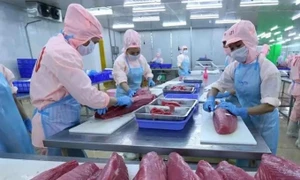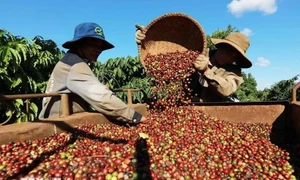
(VNA) – Tran Phu Lu, Deputy Director of the Investment and Trade Promotion Centre of Ho Chi Minh City (ITPC), said Vietnam's economy experienced impressive growth in 2022. In addition to a faster-than-expected recovery in the fields of manufacturing, services and domestic consumption, exports were a main driving force, he said.
The import-export turnover of goods in the first 10 months of 2022 reached 616 billion USD, up 14% over the same period in 2021. Of which, the export value was 312 billion USD, up 15.9 % year-on-year.
He cited Ho Chi Minh City as an example, attributing the city's growth rate of over 9% to great contribution of import and export activities.
The total export turnover of goods by city enterprises through Ho Chi Minh City ports, including crude oil, in the 10 months of 2022 hit nearly 36 million USD, up 10.1% over the same period in 2021. Commodity groups that have enjoyed robust year-o0n-year growth are textile and garment, up 42.7%; machinery, tools and spare parts, 33.5%; and seafood products, 69.7%.
China remained the largest export market for Ho Chi Minh City enterprises with 10-month export turnover reaching 8.2 trillion USD, up 7.3% year-on-year. It was followed by the US and Japan, with 6.3 trillion USD and 2.4 trillion USD, respectively.
Mizushima Kozo, Chairman of the Japan Business Association in HCM City, said that compared to other Southeast Asian countries, Vietnam's economic recovery speed is extremely impressive.
A survey conducted by the association showed 63% of Japanese enterprises said they would continue investing in operation expansion in the next 1-2 years, reflecting that investors have great expectations for Vietnam's economic growth.
According to Lu, difficulties facing the world economy and global trade are forecast to remsin in early 2023 and Vietnam's export growth will depend on inflation situation as well as pandemic prevention and control measures in large export markets. However, he said, it also provides an opportunity for enterprises to overcome challenges and maintain the export growth.
Export enterprises can take advantage of tariff reductions under free trade agreements (FTAs) that Vietnam has signed, especially new-generation FTAs such as the Comprehensive and Progressive Agreement for Trans-Pacific Partnership (CPTPP) and European Union-Vietnam Free Trade Agreement (EVFTA), he said.
As Vietnamese goods have affirmed their quality and prestige, and the structure of exports has also undergone a strong shift from exporting raw materials to processed products with high added value, enterprises should seize this opportunity to expand export markets and increase their export turnover, Lu said.
Talking about Vietnam's export potential, Alex Tatsis, Economic Section Chief at the US Consulate General in HCM City, said that Vietnam is the 10th largest trading partner of the US globally and an important link in the supply chain of essential goods to the US economy.
US supply chain links with Vietnam are not one-way, he said, saying that Vietnam imports computer chips, hardwoods, cotton, and animal feed from the US to use as raw materials for producing semiconductors, furniture, apparel and domestic seafood.
Two-way trade enables Vietnam to develop its domestic economy and exports to global markets. That is why the US has paid attention to investment to help Vietnam strengthen its role in the global supply chain in the long term, he said.
The US enhances trade faciliation and the competitiveness of the private sector in Vietnam, helping small and medium-sized enterprises to improve their production capacity, access financial resources, and embark on digital transformation, Tatsis said, adding that this enables them better participate in the global supply chain for the mutual benefits of the two countries.























